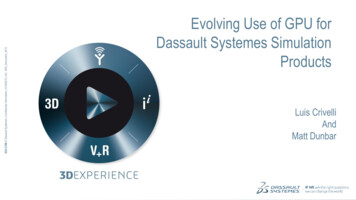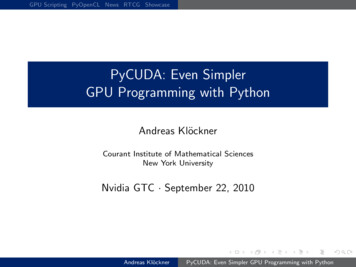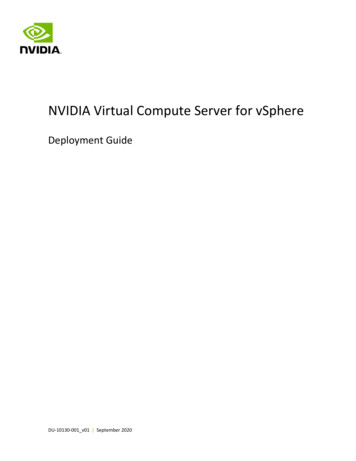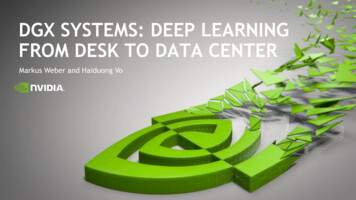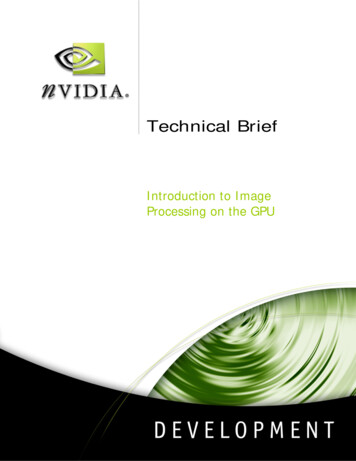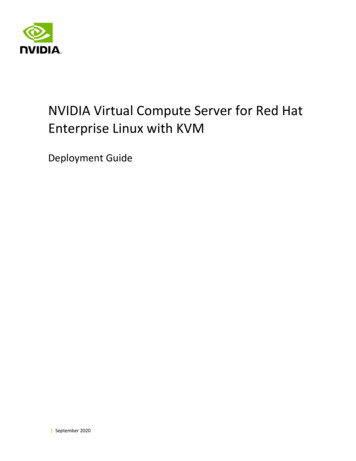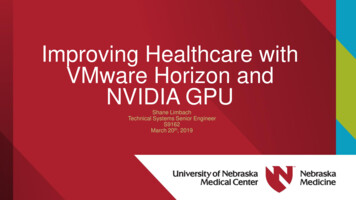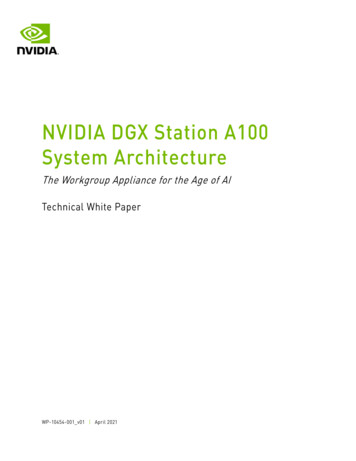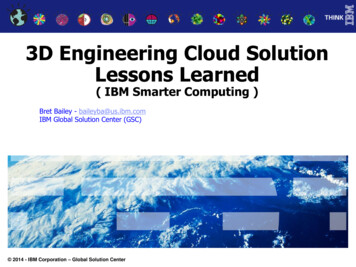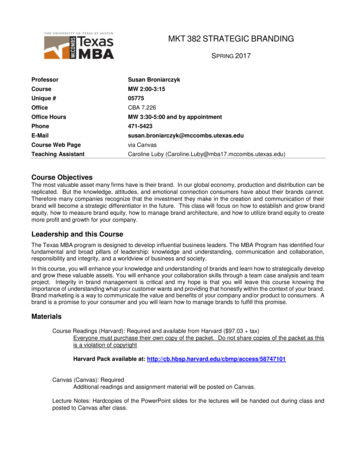
Transcription
NVIDIA Virtual GPU PositioningSelecting the Right GPU for Your Virtualized WorkloadTechnical BriefTB-09867-001 v02 October 2021
TB-09867-001 v02Table of ContentsIntent of this Technical Brief. 1Executive Summary . 2Introduction . 3Selecting the Right Virtual GPU Software . 3NVIDIA GPUs Recommended for Virtualization . 7Selecting the Right GPU . 9Professional Graphics . 11AI Deep Learning Training . 12AI Deep Learning Inference . 14Knowledge Workers. 17NVIDIA AI Enterprise vs. Bare Metal . 19Impact of GPU Sharing . 20NVIDIA AI Enterprise Scale Out . 22Conclusion . 23Resources Links . 24NVIDIA Virtual GPU PositioningTB-09867-001 v02 ii
Intent of this Technical BriefThe flexibility of the NVIDIA vGPU solution sometimes leads to the question, “How do I select the rightsoftware license and GPU combination to best meet the needs of my workloads?”In this technical brief, you will find guidance on how to select the best virtual GPU software licenseand graphics processing unit (GPU) combination, based on your workload. This guidance is based onvariables such as performance and performance per dollar1. Other factors that should be consideredinclude things like which NVIDIA vGPU certified OEM server you’ve selected, which NVIDIA GPUs aresupported in that platform, as well as any power and cooling constraints.Note:1Performance per dollar assumes estimated GPU street price plus NVIDIA virtual GPU software licensecost with 3- or 4-year subscription divided by the number of users.NVIDIA Virtual GPU PositioningTB-09867-001 v02 1
Executive SummaryThis technical brief provides general guidance based on performance and price for virtualizedworkloads using NVIDIA virtual GPU software. It is recommended that you test your unique workloadsto determine the best NVIDIA virtual GPU solution to meet your needs. However, for those who wantto better understand best practices for accelerating workloads in a virtualized infrastructure, thistechnical brief serves as a great starting point.Table 1 summarizes the recommended GPU for running a specific virtualized workload, based only onperformance. For this testing, we selected a representative benchmark for each workload, describedin Table 5. For the specific benchmarks run with NVIDIA virtual GPU software, NVIDIA A40 GPUsprovided the best performance for professional graphics and rendering workloads, while the A100provided the best performance for artificial intelligence (AI) including deep learning training and deeplearning inferencing.In many cases, raw performance is not the only factor considered when selecting the right virtual GPUsolution for your workload. Cost is often also considered. Table 2 summarizes the recommended GPUif only performance per dollar is considered. If the infrastructure will support only a knowledgeworker VDI workload, the A16 GPU provides the best performance per dollar, while also providing thebest user density. The A40 GPU provides the best performance per dollar for professional graphicsapplications. It is important to note, for AI training workloads, time-to-solution is extremelyimportant, and for that reason, costs outside of just infrastructure should be considered. For example,highly paid data scientists and analysts can achieve results orders of magnitude faster when using theunprecedented acceleration offered by the A100. As such, A100 would be recommended for thisworkload when considering these other cost factors.Table 1.WorkloadProfessional GraphicsAI DeepLearningTrainingGPUA40A100Table 2.1Best Performance GPU per WorkloadAI Deep LearningInferenceA100Knowledge WorkersA40 and A16 performthe same 1Best Performance per Dollar GPU per WorkloadWorkloadProfessionalGraphicsAI Deep LearningTrainingAI Deep NVIDIA A100 and A30 are not supported for graphics workloads.NVIDIA Virtual GPU PositioningTB-09867-001 v02 2
IntroductionThe NVIDIA virtual GPU (vGPU) solution provides a flexible way to accelerate virtualized workloads –from AI to VDI. The solution includes NVIDIA virtual GPU software and NVIDIA data center GPUs.There are several unique NVIDIA virtual GPU software licenses, each priced and designed to address aspecific use case.For VDI workloads, leverage the following software licenses: NVIDIA Virtual PC (vPC)/Virtual Applications (vApps) – accelerates office productivity applications,streaming video, Windows, RDSH, multiple and high-resolution monitors and 2D electric designautomation (EDA). NVIDIA RTX Virtual Workstation (RTX vWS) – accelerates professional design and visualizationapplications including Autodesk Revit, Maya, Dassault Systèmes CATIA, Solidworks, Esri ArcGIS Pro,Petrel, and more.For AI, data science and high-performance computing workloads, leverage the following softwarelicenses: NVIDIA AI Enterprise – an end-to-end cloud-native suite of AI and data analytics software,including NVIDIA vGPU software, that is optimized, certified, and supported by NVIDIA to run onVMware vSphere with NVIDIA-Certified Systems. NVIDIA Virtual Compute Server (vCS) – accelerates artificial intelligence (AI), deep learning (DL),data science and high-performance computing (HPC) workloads in a virtualized environment withRed Hat Virtualization or other KVM-based hypervisors.Decoupling the GPU hardware and virtual GPU software options enables customers to benefit frominnovative features delivered in the software at a regular cadence, without a dependency onpurchasing new GPU hardware. It also provides the flexibility for IT to architect the optimal solution tomeet the specific needs of users in their environment.Selecting the Right Virtual GPU SoftwareSelect your NVIDIA virtual GPU software license based on the workload(s) your users are running.Table 3 shows the feature differences between the NVIDIA vGPU software license options. NVIDIA vPCsoftware is selected for knowledge worker VDI to run office productivity applications. NVIDIA RTXvWS is selected to virtualize professional visualization applications which benefit from the RTXEnterprise platform drivers and ISV certifications, support for NVIDIA CUDA and OpenCL, higherresolution displays, and larger profile sizes. For server virtualization to run compute workloads such asAI, data science and HPC, with VMware vSphere, the NVIDIA AI Enterprise license, which includes adriver that has been tested to run these compute workloads, would be selected. Or leverage theNVIDIA Virtual Compute Server (vCS) software license for compute workloads with KVM hypervisors.NVIDIA Virtual GPU PositioningTB-09867-001 v02 3
IntroductionNVIDIA Virtual GPU PositioningTB-09867-001 v02 4
IntroductionTable 3.NVIDIA Virtual GPU Software FeaturesConfiguration and DeploymentNVIDIA RTX vWSNVIDIA vPCWindows OS Support Linux OS Support NVIDIA Graphics Driver NVIDIA RTX Enterprise Driver NVIDIA AIEnterprise or vCS NVIDIA Compute DriverMulti-vGPU/NVLink GPUDirect Support GPU Operator ECC Reporting and Handling Page Retirement DisplayNVIDIA RTX vWSNVIDIA vPCNVIDIA AIEnterprise or vCSFour 5K, Two 8KFour QHD, Two 4K,One 5KOne 4KMaximum Resolution7680x43025120x28804096x2160Maximum Pixel Count66,355,20017,694,7208,847,360NVIDIA RTX vWSNVIDIA vPCNVIDIA AIEnterprise or vCSMaximum Hardware Rendered DisplayAdvanced Professional FeaturesISV Certifications NVIDIA CUDA/OpenCL Graphics Features and APIsNVENCNVIDIA Virtual GPU Positioning NVIDIA RTX vWSNVIDIA vPCNVIDIA AIEnterprise or vCS TB-09867-001 v02 5
IntroductionOpenGL Extensions (WebGL) Insitu Graphics/GL Support RTX Platform Optimizations DirectX Vulkan Support ProfilesMax Frame Buffer SupportedAvailable Profiles NVIDIA RTX vWSNVIDIA vPCNVIDIA AIEnterprise or vCS48GB2GB80GB0Q, 1Q, 2Q, 3Q,4Q, 6Q, 8Q, 12Q,16Q, 24Q, 32Q,48Q0B, 1B, 2B4C, 5C, 6C, 8C, 10C,12C, 16C, 20C, 24C,40C, 80CRefer to the respective sizing guides for NVIDIA Virtual PC (vPC), NVIDIA RTX Virtual Workstation(vWS) and NVIDIA AI Enterprise for additional details on how to best configure an acceleratedvirtualized infrastructure.NVIDIA Virtual GPU PositioningTB-09867-001 v02 6
NVIDIA GPUs Recommended forVirtualizationTable 4 shows the NVIDIA GPUs recommended for virtualization workloads. The GPUs in this table aretested and supported with NVIDIA virtual GPU software. Refer to the NVIDIA virtual GPU productdocumentation for the full support matrix details.Table 4.NVIDIA GPUs Recommended for pere)(Ampere)---- 40/80GB HBM224GB HBM248GB GDDR664GB GDDR6GPUs/Board(Architecture)RTX TechnologyMemory Size(16GB per GPU)vGPU Profiles(GB)4, 5, 8, 10, 16, 20, 40,804, 6, 8, 12, 241, 2, 3, 4, 6, 8, 12, 16,24, 481, 2, 4, 8, 16MIG SupportUp to 7Up to 4NoNoYesYesYesNoForm FactorSXM4 and PCIe 4.0Dual SlotPCIe 4.0 Dual SlotPCIe 4.0 Dual SlotPCIe 4.0 Dual SlotPower t PerformanceAI and HPCMainstream AI andHPCHigh-end VirtualWorkstations or mixedvirtual workstationsand compute (AI, datascience)Knowledge WorkerVirtual Desktops,NVLink SupportOptimized ForTargetWorkloadsNVIDIA Virtual GPU PositioningEntry VirtualWorkstationsTB-09867-001 v02 7
NVIDIA GPUs Recommended for VirtualizationThe NVIDIA GPUs recommended for virtualization are divided into two categories: Performance Optimized GPUs are typically recommended for high-end virtual workstationsrunning professional visualization applications, or for running compute-intensive workloads suchas artificial intelligence, deep learning, or data science workloads. Density Optimized GPUs are typically recommended for knowledge worker virtual desktopinfrastructure (VDI) to run office productivity applications, streaming video and Windows. They aredesigned to maximize the number of VDI users supported in a server.NVIDIA Virtual GPU PositioningTB-09867-001 v02 8
NVIDIA GPUs Recommended for VirtualizationBuilt on the innovative NVIDIA RTX platform, the NVIDIA A40 GPU is uniquely positioned to power themost demanding professional visualization workloads. NVIDIA A40 is an integral part of the NVIDIAEGX Platform for Professional Visualization, which can run various accelerated graphics workloadsincluding powerful virtual workstations. The NVIDIA A40 provides the best performance for graphicsworkloads and features larger (48GB) memory, but with NVIDIA NVLink can support up to 96GB topower virtual workstations that support very large animations, files, or models.The NVIDIA A100 is the most advanced data center GPU ever built to accelerate AI, high performancecomputing, and data science. Customers who train or use neural networks, use computationallyintensive applications, or run simulations requiring double precision accuracy (FP64 performance)should be using the A100, which provides the best time-to-solution. A100 is available in two formfactors, PCIe and SXM module. The SXM module is available with servers that support NVIDIA NVLink , provide the best performance and strong scaling for hyperscale and HPC data centersrunning applications that scale to multiple GPUs, such as deep learning.Selecting the Right GPUWhile many organizations seek the highest performing GPU or the GPU that provides the bestperformance per dollar, there are other factors like performance per watt or form-factor that can betaken into consideration.Workloads have been executed on an industry standard dual socket server with VMware vSphere 7U2 and NVIDIA vGPU 13.0 using vGPU 1:1 profile unless otherwise stated. 1:1 vGPU profilescorrespond to the full GPU allocated to a single virtual machine. This was chosen as the impact ofscaling does not differ between GPUs 2. See “Impact of GPU Sharing” section for more details.Note that the comparisons should be used as general guidance when choosing GPUs based onperformance or performance per dollar. All recommendations are based on the workloads listed inTable 5 which could differ from the applications being used in production.2Assumes that enough frame buffer is available on all vGPUs across all GPUs.NVIDIA Virtual GPU PositioningTB-09867-001 v02 9
Table 5.Description of Benchmarks UsedWorkloadDescriptionvGPU Software EditionProfessionalGraphicsSPECviewperf 2020 (4K)NVIDIA RTX vWSAI DeepLearningTrainingThe SPECviewperf 2020 is a standard benchmark formeasuring graphics performance based on professionalapplications. The benchmark measures the 3D graphicsperformance of systems running under the OpenGL andDirect X application programming interfaces.BERT Large Fine Tune Training, Batch Size: 32* number ofGPUs; Precision: Mixed; Data Real; Sequence Length: 384;cuDNN Version: 8.1.0.77; NCCL Version: 2.8.4; Baseline: DL21.02; Installation Source: NGCNVIDIA AI EnterpriseBERT is one of today’s most widely used natural languageprocessing models.AI DeepLearningInferenceKnowledgeWorkerBERT Large Inference; Batch Size: 128 INT8; Seq-Len: 128NVIDIA AI EnterpriseBERT is one of today’s most widely used natural languageprocessing models.NVIDIA nVector Digital Worker WorkloadNVIDIA vPCNVIDIA’s nVector benchmarking tool that simulates the enduser workflow and measures key aspects of the userexperience, including end-user latency, framerate, imagequality and resource utilization.NVIDIA Virtual GPU PositioningTB-09867-001 v02 10
NVIDIA GPUs Recommended for VirtualizationProfessional GraphicsThe NVIDIA A40 is based on the NVIDIA Ampere architecture, which features second-generation RTCores to deliver massive speedups for workloads like photorealistic rendering of movie content,architectural design evaluations, and virtual prototyping of product designs. RT cores also speed upthe rendering of ray-traced motion blur for faster results with greater visual accuracy and cansimultaneously run ray tracing with either shading or denoising capabilities. The significantly higherpower budget of the NVIDIA A40 enables it to provide the highest graphics performance.Figure 1.RTX vWS SPECviewperf2020 PerformanceNVIDIA A40 for the Best Professional Graphics Performance(Higher is Better)32.4Geomean (Normalized)2.521.81.51.010.500.5A16T4RTX 6000A40SPECviewperf2020NVIDIA Virtual GPU PositioningTB-09867-001 v02 11
NVIDIA GPUs Recommended for VirtualizationFigure 2.RTX vWS SPECviewperf2020 Performance per DollarA40 for Best Professional Graphics Performance per Dollar(Higher is Better)1.41.3Geomean (Normalized)1.210.91.01.0T4RTX 60000.80.60.40.20A16A40SPECviewperf2020Figure 2 assumes estimated GPU street price plus NVIDIA RTX vWS software cost with 4-yearsubscription with one user per GPU.AI Deep Learning TrainingA100, based on the NVIDIA Ampere architecture, is designed to bring AI to every industry. The A100 isbuilt to accelerate AI, and it is no surprise that it provides the highest performance for deep learningtraining workloads. It is important to note, for deep learning training workloads, time-to-solution isextremely important. For example, the cost of having highly paid data scientists wait for results couldoutweigh the benefits of a slightly lower cost solution, so A100 would be recommended whenconsidering these other cost factors.NVIDIA Virtual GPU PositioningTB-09867-001 v02 12
NVIDIA GPUs Recommended for VirtualizationFigure 3.NVIDIA AI Enterprise Deep Learning Training PerformanceA100 for Best Deep Learning Performance(Higher is Better)76.4Performance (Normalized)653.943.032100.6A161.0T4A30A40A100BERT Large Fine Tune TrainingNVIDIA Virtual GPU PositioningTB-09867-001 v02 13
NVIDIA GPUs Recommended for VirtualizationFigure 4.NVIDIA AI Enterprise Deep Learning Training Performance per DollarA100 for Best Deep Learning Performance per Dollar(Higher is Better)76.4Performance (Normalized)6543.32.732100.6A161.0T4A30A40A100BERT Large Fine Tune TrainingFigure 4 assumes estimated GPU street price plus NVIDIA AI Enterprise software cost with 3-yearsubscription.AI Deep Learning InferenceFor deep learning inference workloads, cost is often an important consideration. Therefore, theNVIDIA A30 is typically the preferred solution. Environments that prioritize performance as the mostimportant consideration would select the A100. Note that both the A100 and the A30 GPUs supportNVIDIA Multi-Instance GPU (MIG), which partitions the single A100 or A30 GPU into smaller,independent GPU instances which run simultaneously, each with its own memory, cache andstreaming multiprocessors. MIG is not supported on other GPUs such as A16, A40 and T4.NVIDIA Virtual GPU PositioningTB-09867-001 v02 14
NVIDIA GPUs Recommended for VirtualizationFigure 5.NVIDIA AI Enterprise Deep Learning Inference PerformanceA100 for Best Deep Learning Inference Performance(Higher is Better)97.9Performance RT Large InferenceNVIDIA Virtual GPU PositioningTB-09867-001 v02 15
NVIDIA GPUs Recommended for VirtualizationFigure 6.NVIDIA AI Enterprise Deep Learning Inference Performance per DollarA100 for Best Deep Learning Inference Performance/ (Higher is Better)65.2Performance/ (Normalized)543.93.9A40A3032100.6A161.0T4A100BERT Large InferenceFigure 6 assumes estimated GPU street price plus NVIDIA AI Enterprise software cost with 3-yearsubscription.NVIDIA Virtual GPU PositioningTB-09867-001 v02 16
NVIDIA GPUs Recommended for VirtualizationKnowledge WorkersAs more knowledge worker users are added on a server, the server runs out of CPU resources. Addingan NVIDIA GPU for this workload offloads constraints on the CPU resulting in improved userexperience and performance for end users. The NVIDIA nVector knowledge worker VDI workload wasused to test user experience and performance with NVIDIA GPUs combined with NVIDIA vPCsoftware. NVIDIA M10, T4, A16 and A40 achieve similar performance for this workload.For knowledge worker VDI workloads where users are accessing office productivity applications, webbrowsers and streaming video, achieving the highest user density per server and the bestperformance per dollar are important factors. The NVIDIA A16, with its unique quad-GPU on a boarddesign is ideal for providing a high number of users per GPU and the most cost-effective performancefor this use case.Customers are realizing the benefits of increased resource utilization by leveraging commonvirtualized GPU accelerated server resources to run virtual desktops and workstations but leveragingthese same resources to run compute when users are logged off. Customers who want to be able torun compute workloads on the same infrastructure that they run VDI, might leverage an A40 to do so.Learn more about Using NVIDIA Virtual GPUs to Power Mixed Workloads in our whitepaper.Despite having 48GB of frame buffer, the A40 supports a maximum of only 32 users due to reachingthe context switching limit per GPU. Refer to Table 6 to see how many VDI users can be supported foreach GPU (with 1GB profile size).NVIDIA Virtual GPU PositioningTB-09867-001 v02 17
NVIDIA GPUs Recommended for VirtualizationTable 6.Maximum Number of Supported NVIDIA vPC Knowledge Workers (with1GB Profile Size)GPUM10T4A40A16Max. Users perGPU board32163264Max. Users perserver 3969696192Table 6 assumes that each user needs a 1GB profile. However, it is best to conduct a POC todetermine the appropriate profile sizes for the users in the environment to provide the best userexperience.Figure 7.NVIDIA vPC VDI Cost per UserA16 for Best Cost per User(Lower is Better)1.6Cost per User 10A16Figure 7 assumes estimated GPU street price plus NVIDIA vPC software cost with 4-year subscriptiondivided by the number of users.Assumes maximum of 3 M10, A40 or A16 boards per 2U server or up to 6 T4 boards per 2U server. See thespecifications for your preferred OEM server to determine the maximum number of boards supported.3NVIDIA Virtual GPU PositioningTB-09867-001 v02 18
NVIDIA AI Enterprise vs. Bare MetalOrganizations choose to virtualize servers and applications for various reasons (manageability,flexibility, and security to name a few), but traditionally came with performance sacrifice. However,the performance difference of using NVIDIA AI Enterprise is negligible and will depend on theworkload, as well as various other configuration variables. The following example illustrates nearbare-metal performance with NVIDIA AI Enterprise in comparison to a bare metal server running theMLPerf Inference: Datacenter v1.1 Natural Language Processing (BERT-Large) benchmark in a 1:1configuration using the NVIDIA A100 Tensor Core GPU.Figure 9 represents per-accelerator performance derived from the best MLPerf results for respectivesubmissions using the reported accelerator count in Data Center Offline. The server is a Dell EMCPowerEdge R7525, with 3 A100-PCIE-40GB GPUs (configured with 3 GRID A100-40C profiles),TensorRT, AMD EPYC 7502, NVIDIA A100-PCIE-40GB, TensorRT 8.0.2, CUDA 11.3The MLPerf name and logo are trademarks. Refer to www.mlcommons.org for more information.Figure 9.Inference Benchmark1.21.00.80.60.40.20.0BERT-Large HighAccuracy OfflineBERT-Large OfflineSamples per Second - Relative Performance3x A100-40c Virtualized using NVIDIA AI EnterpriseNVIDIA Virtual GPU Positioning3x A100 Bare MetalTB-09867-001 v02 19
Impact of GPU SharingImproving overall utilization through sharing a GPU across multiple virtual machines with NVIDIAvGPU software is implemented by scheduling the time which each virtual machine can use the GPU.NVIDIA vGPU software provides multiple GPU scheduling options to accommodate a variety of Qualityof Service (QoS) levels for sharing the GPU. View the NVIDIA vGPU product documentation for moreinformation about GPU scheduling options.In general, the performance per virtual machine when sharing a GPU with n virtual machines will be1/n of the total performance of the GPU. Therefore, two virtual machines sharing a GPU will result inapproximately 50 percent of the overall performance per virtual machine and four virtual machineswill result in approximately 25 percent of the overall performance per virtual machine.Figure 10 is an illustration of multiple virtual machines with an overall throughput increase of 16%.Figure 10.Virtual GPU Sharing1st VM2nd VM3rd VM4th VM1.2Geomean 7A40-48QSingle VMNVIDIA Virtual GPU PositioningA40-24QTwo VMsA40-12QFour VMsTB-09867-001 v02 20
Impact of GPU SharingHowever, when workloads across virtual machines are not executed at the same time, or aren’talways GPU bound, the performance can exceed the expected performance. The default GPUscheduling policy, “Best Effort,” will be selected for this to happen as it leverages unused GPU time ofother virtual machines. See Figure 11 for a simplified view of how the “Best Effort” GPU schedulerworks.Figure 11.Best Effort GPU SchedulerNVIDIA Virtual GPU PositioningTB-09867-001 v02 21
NVIDIA AI Enterprise Scale OutThe scaling factor of virtual machines with NVIDIA AI Enterprise distributed deep learning training issimilar to the scaling factor for non-virtualized configurations. NVIDIA AI Enterprise is optimized onVMware vSphere and supports features such as GPUDirect RDMA, ATS (Address Translation Services),and RoCE (RDMA over Converged Ethernet) to provide multinode scale out performance that is nearlyindistinguishable from bare metal.Figure 12 represents a BERT-Large training workload to train a natural language processing modelusing NVIDIA A100 Tensor Core GPUs. With 1 GPU per node, the workload is scaled to 4 nodes withbare metal performance. The system is an Intel Xeon Gold (6240R @ 2.4GHz), Ubuntu 18.04, NVIDIAMellanox ConnectX6 Dx, RoCE enabled, ATS enabled, TensorFlow BERT Large Training using Horovod,FP16, BS:30, Seq Len: 384, 1 NVIDIA A100 GPU per node, guest driver 460.32.04, GPU virtualized withVMware vSphere 7.0u2 and an NVIDIA vGPU 12.0 (40C profile).Figure 12. NVIDIA AI Enterprise Distributed Deep Learning Training Performance3X2X1X0X1 Node2 Node Cluster3 Node Cluster4 Node ClusterSentences per Second - Relative PerformanceGPU VirtualizedNVIDIA Virtual GPU PositioningGPU Bare MetalTB-09867-001 v02 22
ConclusionThe NVIDIA vGPU software solution offers unmatched flexibility and performance when paired withthe latest generation GPUs based on the NVIDIA Ampere architecture. The solution is designed tomeet the ever-shifting workloads and organizational needs of today’s modern enterprises. Forprofessional visualization workloads, the NVIDIA A40 GPU is uniquely positioned to power the mostdemanding graphics and rendering workloads for dynamic virtual workstations while also offering themost cost-effective performance for professional graphics applications. If the infrastructure willsupport knowledge worker VDI workloads, the A16 GPU provides the most cost-effectiveperformance, while also providing the best user density. And finally, for AI workloads including deeplearning training and deep learning inferencing, the NVIDIA A100 is the most advanced data centerGPU ever built to accelerate AI, high-performance computing, and data science with unprecedentedacceleration, while the NVIDIA A30 provides the most cost-effective performance for inferencingworkloads.While this technical brief provides general guidance on how to select the right NVIDIA GPU for yourworkload, actual results may vary depending on the specific application being virtualized.The most successful deployments are those that balance virtual machine density (scalability) withrequired performance. This is achieved when a proof of concept (POC) with production workloads isconducted while analyzing the utilization of all resources of a system and gathering subjectivefeedback from all stakeholders. Consistently analyzing resource utilization and gathering subjectivefeedback allows for optimizing the configuration to meet the performance requirements whileoptimizing the configuration for best scale.NVIDIA Virtual GPU PositioningTB-09867-001 v02 23
Resources LinksNVIDIA vPC Resources:NVIDIA vPC Windows 10 Profile Sizing GuidanceQuantifying the Impact of NVIDIA Virtual GPUsNVIDIA vPC Solution OverviewNVIDIA vPC webpageNVIDIA RTX Virtual Workstation Resources:NVIDIA RTX Virtual Workstation Application Sizing GuideNVIDIA RTX vWS Solution OverviewNVIDIA RTX vWS webpageNVIDIA AI Enterprise Software Suite Resources:NVIDIA AI Enterprise webpageNVIDIA AI Enterprise Solution OverviewNVIDIA AI Enterprise Sizing GuideOther Resources:Try NVIDIA vGPU for freeUsing NVIDIA Virtual GPUs to Power Mixed WorkloadsNVIDIA Virtual GPU Software DocumentationNVIDIA vGPU Certified ServersNVIDIA Virtual GPU PositioningTB-09867-001 v02 24
NoticeThis document is provided for information purposes only and shall not be regarded as a warranty of a certain functionality, condition, or quality of a product.NVIDIA Corporation (“NVIDIA”) makes no representations or warranties, expressed or implied, as to the accuracy or completeness of the information containedin this document and assumes no responsibility for any errors contained herein. NVIDIA shall have no liability for the consequences or use of such information orfor any infringement of patents or other rights of third parties that may result from its use. This document is not a commitment to develop, release, or deliver anyMaterial (defined below), code, or functionality.NVIDIA reserves the right to make corrections, modifications, enhancements, improvements, and any other changes to this document, at any time without notice.Customer should obtain the latest relevant information before placing orders and should verify that such information is current and complete.NVIDIA products are sold subject to the NVIDIA standard terms and conditions of sale supplied at the time of order acknowledgement, unless otherwise agreedin an individual sales agreement signed by authorized representatives of NVIDIA and customer (“Terms of Sale”). NVIDIA hereby expressly objects to applying anycustomer general terms and conditions with regards to the purchase of the NVIDIA product referenced in this document. No contractual obligations are formedeither directly or indirectly by this document.NVIDIA products are not designed, authorized, or warranted to be suitable for use in medical, military, aircraft, space, or life support equipment, nor in applicationswhere failure or malfun
Decoupling the GPU hardware and virtual GPU software options enables customers to benefit from innovative features delivered in the software at a regular cadence, without a dependency on purchasing new GPU hardware. It also provides the flexibility for IT to architect the optimal solution to meet the specific needs of users in their environment.
